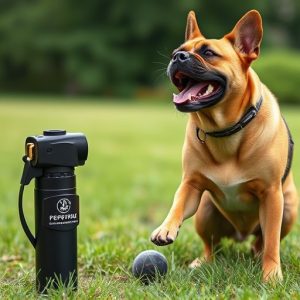Canine Repellent Spray: Safety, Application Tips & Emergency Care for Maked Animals
Canine repellent spray, using natural or synthetic compounds, protects against unwanted dog encounte…….
Canine repellent spray, using natural or synthetic compounds, protects against unwanted dog encounters outdoors. Safety is paramount; use pet-safe formulations approved by veterinary organizations according to manufacturer instructions as preventive measures. If your pet is sprayed, seek immediate emergency care from a veterinarian, as effects can have delayed reactions. Consistency in application, testing on sensitive areas, and regular training sessions are vital for maximum protection and reducing repellent dependency. Prevention and basic knowledge of emergency care for maced animals are key.
“Protecting yourself and your loved ones from aggressive dogs is a serious matter, especially in today’s active outdoors. Canine repellent spray emerges as a valuable tool in personal safety gear, offering an instant solution during unexpected encounters with hostile canines. This comprehensive guide delves into the intricacies of canine repellent spray, exploring its active ingredients, safety measures, and effective application techniques. We also shed light on crucial emergency care for maced animals, enhancing your situational awareness and preparedness.”
- Understanding Canine Repellent Spray: Active Ingredients and Safety
- When to Use Emergency Care for Maced Animals: Situational Awareness
- Application Techniques and Tips for Effective Protection
Understanding Canine Repellent Spray: Active Ingredients and Safety
Canine repellent spray is a handy tool for protecting yourself and your pets from unwanted canine encounters, especially during outdoor activities. When choosing a repellent, understanding its active ingredients is key. These sprays typically contain natural or synthetic compounds that act as scent markers or irritants to deter dogs. Common active ingredients include capsaicin (derived from chili peppers), citronella oil, and certain plant extracts known for their unpleasant odour to canines.
Safety should always be a priority when using any chemical product, especially around animals. Repellent sprays designed for dogs are formulated to be pet-safe, but it’s crucial to follow the manufacturer’s instructions carefully. These products are not intended as emergency care for maced animals; instead, they serve as a preventive measure. Look for sprays approved by veterinary organizations and ensure they are used appropriately to avoid any potential side effects or allergic reactions in your pets.
When to Use Emergency Care for Maced Animals: Situational Awareness
If your pet is exposed to or sprayed by a potential predator, immediate action is crucial. Understanding when to seek emergency care for maced animals requires situational awareness and knowledge of their behavior. Look for signs that indicate distress, such as excessive whining, panting, pacing, or dilated pupils. If your dog shows any of these symptoms after an encounter, it’s time to act fast.
Seek veterinary assistance promptly, as the effects of the spray can be delayed and may lead to more severe reactions later. The vet will assess the severity of the reaction and provide appropriate treatment, which could range from topical cleaning and monitoring to more intensive care depending on the level of exposure and your pet’s overall health.
Application Techniques and Tips for Effective Protection
When applying canine repellent spray, consistency is key. Regular application throughout the day, especially before outings or during peak hours, ensures maximum protection. Target areas like legs, neck, and base of the tail, as dogs tend to scratch and lick these spots if they sense an irritation. Start by testing a small amount on your hand to ensure it’s not too strong for sensitive skin, then spray liberally onto your dog’s coat, allowing it to dry before they engage in outdoor activities.
Remember, prevention is better than cure when it comes to emergency care for maced animals. Choose a spray that suits your dog’s needs and tolerance level. Keep the spray within reach during walks or outings, and ensure you know how to administer first aid if an attack occurs. Regular training sessions can also help desensitize your dog to potential threats, reducing the need for frequent repellant use.
Canine repellent spray is a valuable tool for personal protection against aggressive dogs, as demonstrated by the importance of understanding its active ingredients, safety measures, and effective application techniques. When faced with an unexpected encounter, knowing when to seek emergency care for maced animals is crucial for your well-being. By combining situational awareness with proper usage, you can ensure maximum protection during outdoor activities. Remember, prevention and preparation are key, so always carry and familiarize yourself with this powerful tool.


